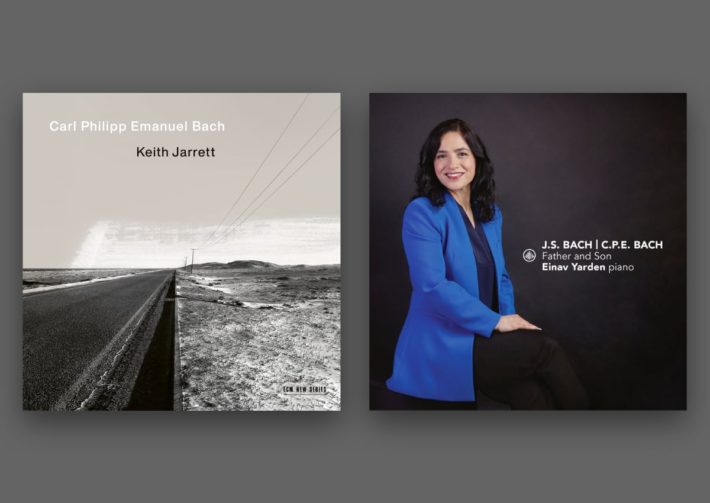Both albums here make central “Father and Son,” — the relationship between J.S. and C.P.E. Bach. Paul Griffiths, who authors Keith Jarrett’s album notes, presents this concept as a narrative while Einav Yarden makes her reflection in her artist’s foreword. This thematic concept marks the end of the commonality, as there are actually no shared selections between the two discs.
Amazon: C.P.E. Bach: Württemberg Sonatas – Keith Jarrett, Piano

Amazon: Father & Son – Einav Yarden, Piano

Keith Jarrett’s body of work in the classical genre impressively matches that of his jazz. Bach projects include a live recording of the Well Tempered Clavier Book 1 (1987) and the Goldberg Variations—on harpsichord—two years later. C.P.E.’s 6 Württemberg Sonatas are the subject of this 1994 recording; he mentions that even after listening to harpsichord versions, he felt there is still a space for a modern piano rendition. The A Minor Sonata sees Jarrett giving the low and middle ranges an assertive robustness and the upper a lovely, delicate transparency. However, the work (especially the opening movement) needs more urgency. The want for more drama isn’t entirely the pianist’s responsibility but also that of the medium itself. Mahan Esfahani’s recording on harpsichord (Hyperion), for instance, sounds totally different: there is much more rhythmic definition in his phrases and the plucked timbre is crucial in adding necessary vitality.
Elegant restraint is exactly what makes the opening movement of Jarrett’s A-flat major Sonata docile and pleasant but again quite even-keeled. With the harmonic progressions the composer has to offer, I was hoping for more responsiveness by way of distinct dynamics and tone qualities. The second movement fares better in this regard. There are more interesting and perceptible differences between major and minor tonal centers, which complement the underlying spirit that is graceful and coy. One especially interesting perspective this performance reveals is an almost fortepiano-like quality of the instrument (Jarret’s beloved Bosendorfer? The booklet doesn’t specify.) Part of this has to do with the piano’s natural temperament but the pianist’s articulation enunciates individual notes, even in the tightest trills. This helps evoke a realistic sound resembling leather hammers hitting the strings.
Related Classical Music Posts
- Review: Fantasie – Alexander Melnikov
- Review: Mozart & Contemporaries – Víkingur Ólafsson, Piano
- Bach – A Beginner’s Guide
While Jarrett rounds out edges and takes a more sostenuto approach to phrases, Yarden plays with more angularity, as we hear in the Wq. 48/2 “Prussian” Sonata. Her articulation lies between a light legato and a crisp staccato, which results in the runs of the first movement having plenty of delightful zing. I only wished she would use more of her delightful legato in the Adagio to uphold the continuity of the melody. The varied shifts in color and expressive qualities, however, adds a refreshing contour. The final movement sees the return of the peppery staccatos and very clean and balanced harmonic intervals.
As for the JS Bach selections, the Chromatic Fantasia and Fugue is lovely, featuring the same clarity heard in the previous selection. Yarden makes the rightful decision to use pedal most sparingly: we hear just a touch in the improvisatory section at 1’23”, but she mainly relies on a finger legato as well as the ongoing arpeggio textures to fill the soundspace. The middle section offers a contrast to the sprawling opening by way of slower-moving notes. However, Yarden does keep the lyricism of the melody going, albeit in subdued fashion. In the fugue, not only are voices and thematic entrances consistently clear, but Yarden also manages to give themes in different registers unique personalities, as an animated conversation.
The sound engineering has a considerable impact on the performances with things lying decidedly in Yarden’s favor: the mic placement and management of reverb makes her sounds pristine and direct. While Jarrett’s admittedly brings out nuances and his solid fingerwork, it makes his playing regretfully bland and uniform throughout. Turning up the volume seems to reveal more pianistic details but this is hardly an ideal solution.
It might have been nice to hear and compare how Yarden and Jarrett approach an overlapping work, but the albums make each artist’s style and approach clear. It is Yarden’s recording that offers more in terms of personality and excitement, though Jarrett’s is not to be discounted for its sophistication.

C.P.E. Bach – Württemberg Sonatas
Keith Jarrett – Piano
ECM, CD 4858495

Father & Son
Einav Yarden – Piano
Challenge Classics, CD CC72952

Recommended Comparisons
Esfahani | Brendel | Hamelin | Pletnev
Read more classical music reviews or visit The Classic Review Amazon store
Follow Us and Comment:
Get our periodic classical music newsletter with our recent reviews, news and beginners guides.
We respect your privacy.









